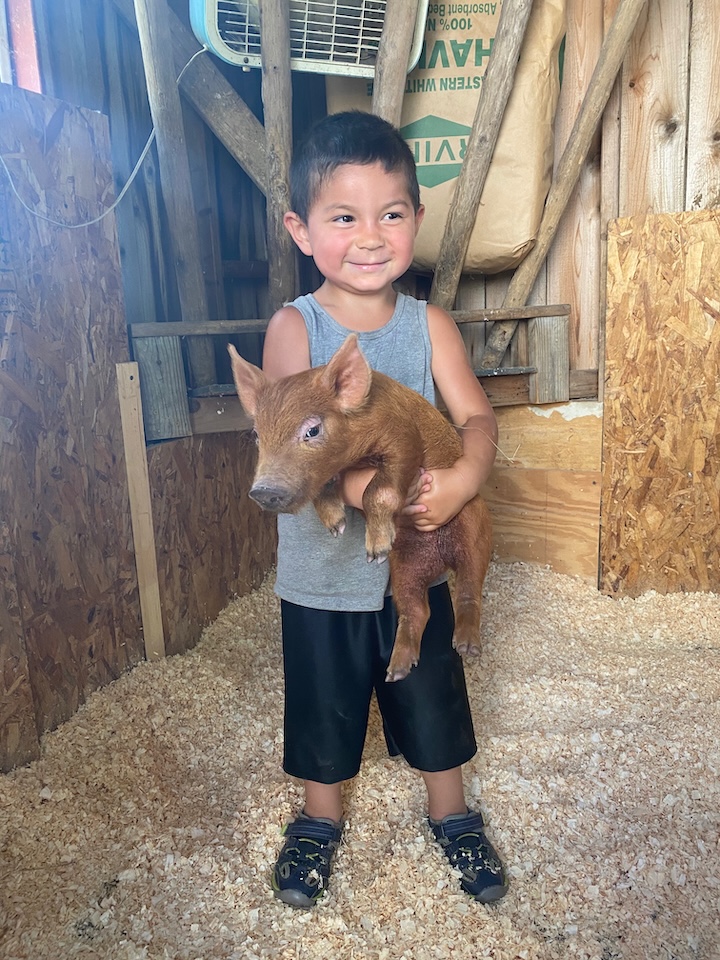By Jacki Martinez Perkins, Organic Dairy and Livestock Specialist
I grew up not only in a different time but also in such a different world than most everyone else I know. My dad was a dairy farmer, and my mom was the only female large animal veterinarian in Maine at the time. By the time I arrived on the scene, the youngest of three with two older brothers, my mom had started her own large-animal veterinary practice as a sole practitioner, and right from the start I was surrounded by warm milk rooms, fuzzy kittens, and the smell of manure. As my brothers and I grew, we became integral employees to the dairy farm, trusted with tasks adult employees struggled to master, and as teens seeking off-farm jobs, we were sought after by employers who knew we had dedication and work ethic.

Was it hard? Yes. Was it often dangerous? Yes. Would I trade it for anything? Not on the lives of my own children. In fact, as a mother myself, now riding a desk chair in my work for MOFGA rather than a farm tractor, I have been taking the best parts of my childhood and folding them into my children’s lives, as well as introducing those lessons to other young people, teens, and curious adults. Introducing youth to livestock can feel daunting and dangerous, but there are reasonable strategies I have seen people use to reap the benefits of living side by side with our fellow creatures.
First and foremost, livestock management should always be approached with intention. Thinking about keeping any infrastructure accessible can take imagination but stepping outside of our own realities is important more broadly than just on our farms and homesteads. For example, if you suddenly have weight-lifting restrictions and can no longer lift buckets, are you able to source longer hoses, or maybe move hay in sleds or wagons? Do the tools you have on hand fit the ergonomics of varying bodies and their abilities? We have a few different wheelbarrow and shovel sizes on our homestead because we take a family approach to chores and even my aging mother finds fulfillment in participating.
One of the next lessons I learned has been caterwauled by many a youngin’s enjoyment of the hit song from the movie “Frozen”: “Let it go, let it gooo … !” We can’t let the way we want a thing to be keep us from letting little ones try. Often, when I work with younger children, I agree to take turns with them so that they can get some practice, but the task will still get done. And while spilled milk and cracked eggs make us adults cringe, you’ll find there will be more tomorrow.
This leads me to safety: both for people and livestock. This is, ultimately, the most time-consuming aspect of keeping livestock and children together, and requires clear and enforced boundaries for all parties, while still allowing for some space for minor scrapes and bruises. I have found the latter piece of this vital in having young people fully grasp the importance of the rules we have in place for handling livestock. The flip side is being sure to use protective gear like gloves, sturdy footwear, and helmets to prevent major accidents. Proper fencing of both livestock and littles creates a physically tangible barrier that helps to keep everyone safe if the responsible party needs their attention elsewhere. Teaching self-awareness and kindness takes time, repetition, and diligence.
While inexperienced individuals need to learn how to handle livestock, it is the responsibility of those well-seasoned in livestock care to know when an animal is unsafe to be around. We grew up with breeding bulls, which after a time tend to become aggressive, and so would inevitably end up in our freezer. Roosters can become a terror and leave people with nasty wounds. Broody hens will peck, rabbits that aren’t handled humanely tend to scratch, and goats and sheep can headbutt the unsuspecting. Using judgment and clear communication are key in building resilience and reducing harm, which are life skills that we can model for young people to carry forward with them as adults. Additionally, the empathy gained in caring for living beings that cannot communicate the same way humans do will help build stronger and more diverse communities as long as we’re taking the time to show children how to ask questions and listen to the world around them.
If you have interest in raising livestock as a part of your own homestead but would like more hands-on learning opportunities, MOFGA works to offer workshops focused on livestock and poultry handling throughout the year. If you don’t see the specific programming you’re interested in, feel free to reach out and let us know. It helps us to build quality programming.
This article was originally published in the fall 2024 issue of The Maine Organic Farmer & Gardener. Browse the archives for free content on organic agriculture and sustainable living practices. Subscribe to the publication by becoming a member!
